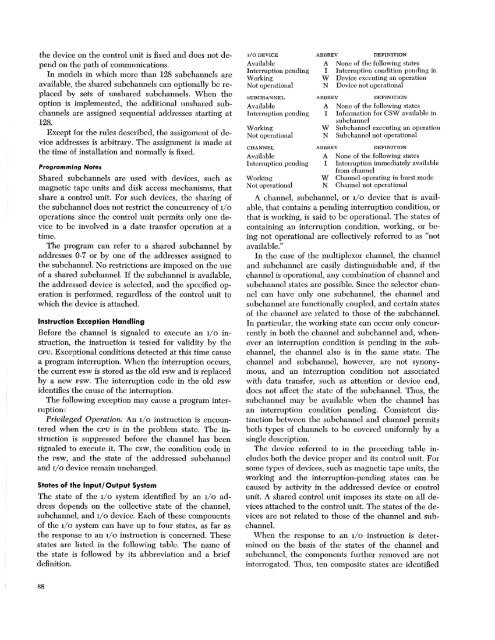Systems Reference Library IBM System/360 Principles of Operation
Systems Reference Library IBM System/360 Principles of Operation
Systems Reference Library IBM System/360 Principles of Operation
You also want an ePaper? Increase the reach of your titles
YUMPU automatically turns print PDFs into web optimized ePapers that Google loves.
the device on the control unit is fixed and does not depend<br />
on the path <strong>of</strong> communications.<br />
In models in which more than 128 sub channels are<br />
available, the shared subchannels can optionally be replaced<br />
by sets <strong>of</strong> unshared subchannels. When the<br />
option is implemented, the additional unshared subchannels<br />
are assigned sequential addresses starting at<br />
128.<br />
Except for the rules described, the assignment <strong>of</strong> device<br />
addresses is arbitrary. The assignment is made at<br />
the time <strong>of</strong> installation and normally is fixed.<br />
Programmill1g Notes<br />
Shared subchannels are used with devices, such as<br />
magnetic tape units and disk access mechanisms, that<br />
share a control unit. For such devices, the sharing <strong>of</strong><br />
the subchannel does not restrict the concurrency <strong>of</strong> I/O<br />
operations since the control unit permits only one device<br />
to be involved in a date transfer operation at a<br />
time.<br />
The program can refer to a shared sub channel by<br />
addresses 0-7 or by one <strong>of</strong> the addresses assigned to<br />
the subchannel. No restrictions are imposed on the use<br />
<strong>of</strong> a shared subchannel. If the subchannel is available,<br />
the addressed device is selected, and the specified operation<br />
is performed, regardless <strong>of</strong> the control unit to<br />
which the device is attached.<br />
Instruction Exception Handling<br />
Before the channel is signaled to execute an I/O instruction,<br />
the instruction is tested for validity by the<br />
CPU. Exceptional conditions detected at this time cause<br />
a program interruption. When the interruption occurs,<br />
the current psw is stored as the old psw and is replaced<br />
by a new psw. The interruption code in the old psw<br />
identifies the cause <strong>of</strong> the interruption.<br />
The following exception may cause a program interruption:<br />
Privileged <strong>Operation</strong>: An I/O instruction is encountered<br />
when the CPU is in the problem state. The instruction<br />
:is suppressed before the channel has been<br />
signaled to execute it. The csw, the condition code in<br />
the psw, and the state <strong>of</strong> the addressed sub channel<br />
and I/O device remain unchanged.<br />
States <strong>of</strong> the Input/Output <strong>System</strong><br />
The state <strong>of</strong> the I/O system identified by an I/O address<br />
depends on the collective state <strong>of</strong> the channel,<br />
sub channel, and I/O device. Each <strong>of</strong> these components<br />
<strong>of</strong> the I/O system can have up to four states, as far as<br />
the response to an I/O instruction is concerned. These<br />
states are listed in the following table. The name <strong>of</strong><br />
the state is followed by its abbreviation and a brief<br />
definition.<br />
88<br />
I/O DEVICE<br />
Available<br />
Interruption pending<br />
Working<br />
Not operational<br />
SUDCHANNEL<br />
Available<br />
Interruption pending<br />
Working<br />
Not operational<br />
CHANNEL<br />
Available<br />
Interruption pending<br />
Working<br />
Not operational<br />
ADBREV DEFINITION<br />
A None <strong>of</strong> the following states<br />
I Interruption condition pending in<br />
W Device executing an operation<br />
N Device not operational<br />
ADDREV DEFINITION<br />
A None <strong>of</strong> the following states<br />
I Information for CSW available in<br />
subehannel<br />
W Subchannel executing an operation<br />
N Subchannel not operational<br />
ADDREV DEFINITION<br />
A None <strong>of</strong> the following states<br />
I Interruption immediately available<br />
from channel<br />
W Channel operating in hurst mode<br />
N Channel not operational<br />
A channel, subchannel, or I/O device that is available,<br />
that contains a pending interruption condition, or<br />
that is working, is said to be operational. The states <strong>of</strong><br />
containing an interruption condition, working, or being<br />
not operational are collectively referred to as "not<br />
available."<br />
In the case <strong>of</strong> the multiplexor channel, the channel<br />
and subchannel are easily distinguishable and, if the<br />
channel is operational, any combination <strong>of</strong> channel and<br />
subchanncl states are possible. Since the selector channel<br />
can have only one subchannel, the channel and<br />
subchannel are functionally coupled, and certain states<br />
<strong>of</strong> the channel are related to those <strong>of</strong> the subchannel.<br />
In particular, the working state can occur only concurrently<br />
in both the channel and subchannel and, whenever<br />
an interruption condition is pending in the subchannel,<br />
the channel also is in the same state. The<br />
channel and sub channel, however, are not synonymous,<br />
and an interruption condition not associated<br />
with data transfer, such as attention or device end,<br />
does not affect the state <strong>of</strong> the subchannel. Thus, the<br />
subchanne.1 may be available when the channel has<br />
an interruption condition pending. Consistent distinction<br />
between the subchannel and channel permits<br />
both types <strong>of</strong> channels to be covered uniformly by a<br />
single description.<br />
The device referred to in the preceding table includes<br />
both the device proper and its control unit. For<br />
some types <strong>of</strong> devices, such as magnetic tape units, the<br />
working and the interruption-pending states can be<br />
caused by activity in the addressed device or control<br />
unit. A shared control unit imposes its state on all devices<br />
attached to the control unit. The states <strong>of</strong> the devices<br />
are not related to those <strong>of</strong> the channel and subchannel.<br />
When the response to an I/O instruction is determined<br />
on the basis <strong>of</strong> the states <strong>of</strong> the channel and<br />
subchannel, the components further removed are not<br />
interrogated. Thus, ten composite states are identified
















